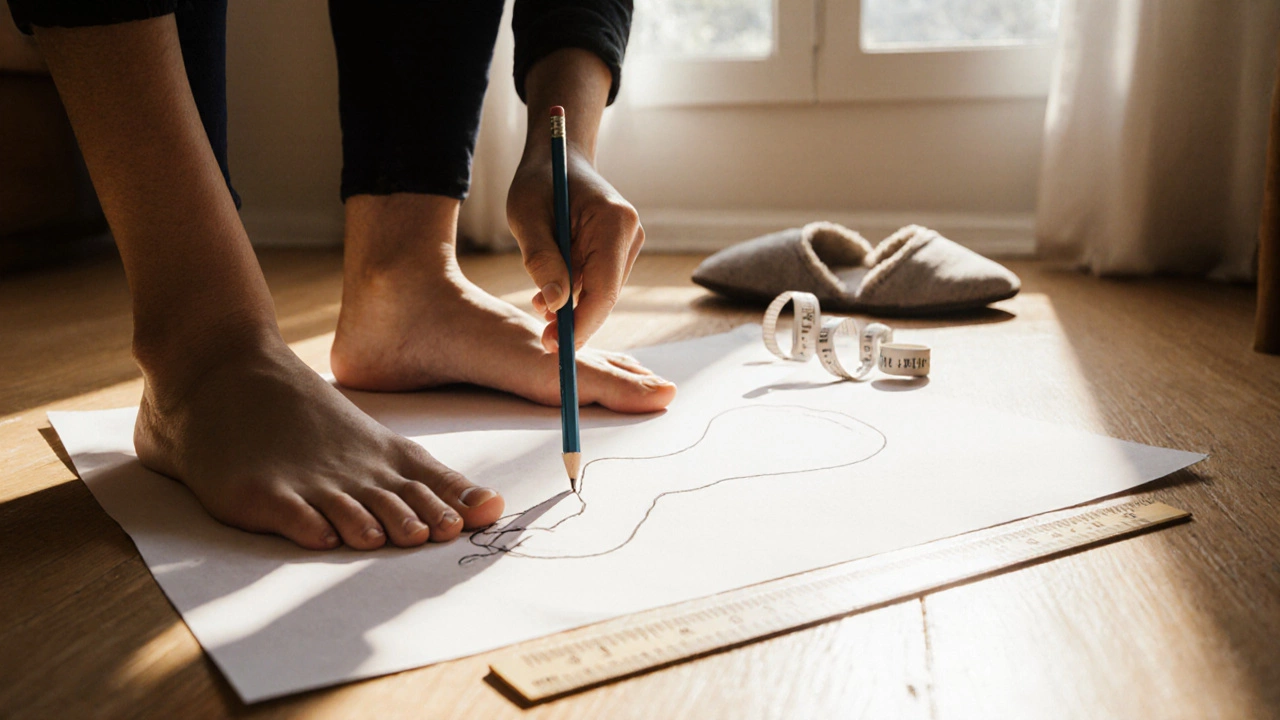Getting slippers that fit right isn’t about guessing or going by your shoe size. It’s about knowing your actual foot dimensions-because slippers aren’t made to squeeze or support like regular shoes. Too tight, and your toes will ache. Too loose, and you’ll trip or develop blisters. And no, just picking your usual shoe size won’t cut it.
Why your regular shoe size doesn’t work for slippers
Slippers are designed for comfort, not structure. They lack arch support, heel counters, and rigid soles. That means they fit differently than sneakers, loafers, or boots. A size 9 in running shoes might be a size 8 or even 7 in slippers, depending on the brand and style. Brands like UGG, Crocs, and Havaianas all size differently. Even the same brand can vary between styles-your favorite fuzzy slipper might run big, while a leather-lined one runs small.
Think of it this way: your foot doesn’t shrink or grow between shoes and slippers. But the way slippers are built changes how they feel on your foot. If you’ve ever worn slippers that felt like they were swallowing your feet, or pinched your heels, you know what happens when sizing goes wrong.
How to measure your feet for slippers
You don’t need fancy tools. Just grab a piece of paper, a pencil, a ruler, and a flat floor. Do this in the afternoon-feet swell a bit during the day, and that’s when they’re at their largest.
- Stand barefoot on the paper with your weight evenly distributed. Don’t curl your toes.
- Trace around your foot with the pencil, holding it upright-not tilted.
- Measure the longest part: from the back of your heel to the tip of your longest toe. Most people think it’s the big toe, but for many, it’s the second toe.
- Measure the widest part of your foot, usually across the ball.
- Repeat for the other foot. Feet are rarely identical. Go with the larger measurement.
Write down both numbers. You’ll need them when checking size charts.
Use a slipper size chart-not your shoe size
Most slipper brands include a size chart on their product page. Look for it. Don’t skip this step. Here’s what to look for:
- Length in centimeters or inches
- Width options (if available)
- Foot length to size conversion
For example, if your foot measures 25.5 cm long, you’re likely a size 7 in UGG slippers, but a size 8 in Crocs. Some brands even list foot length ranges: size 8 = 25-26 cm. Match your measurement to the range, not the number.
Here’s a quick reference for common slipper brands based on foot length (in centimeters):
| Foot Length (cm) | US Women’s Slipper Size | US Men’s Slipper Size | UK Size |
|---|---|---|---|
| 22.5 | 4 | 3 | 2 |
| 23.5 | 5 | 4 | 3 |
| 24.5 | 6 | 5 | 4 |
| 25.5 | 7 | 6 | 5 |
| 26.5 | 8 | 7 | 6 |
| 27.5 | 9 | 8 | 7 |
| 28.5 | 10 | 9 | 8 |
Remember: this is a general guide. Always check the brand’s specific chart. Some slippers, especially fuzzy ones, are meant to be snug at first and stretch slightly with wear. Others, like flip-flop style slippers, need room for your toes to move.
Check for toe room and heel grip
Even with perfect measurements, fit matters. When trying on slippers:
- Stand up. Your longest toe should have about 1 cm of space from the front. No squished toes.
- Walk around. Your heel shouldn’t slip up and down with every step. A little movement is okay, but constant sliding means it’s too big.
- Squeeze the sides. If your foot feels pinched, especially across the ball, go up a size. Slippers shouldn’t compress your foot.
- Test the arch. If the sole feels flat and your foot aches after 10 minutes, the slipper lacks even minimal support.
Don’t rely on how they feel sitting down. Feet change shape when you stand. That’s why you need to walk in them before buying.
What if you’re between sizes?
If your foot measures 25.8 cm and the size chart shows size 7 (25-26 cm) and size 8 (26-27 cm), go with size 7 if the slipper is made of stretchy material like knit or fleece. Go with size 8 if it’s stiff leather, plastic, or has a rigid sole.
Also consider the season. Thick wool slippers will feel tighter than thin cotton ones. If you plan to wear socks inside, add 0.5 cm to your foot measurement. Some brands even say “wear with socks” on the product page. If they do, size up.

Common mistakes people make
Here’s what usually goes wrong:
- Measuring feet while sitting-feet are shorter when you’re not bearing weight.
- Using last year’s shoe size without checking the brand’s current chart.
- Assuming all slippers fit like sandals.
- Buying online without reading reviews about sizing. Look for comments like “ran large” or “true to size.”
- Ignoring width. Wide feet need wide slippers. If your foot is over 10 cm wide, look for brands that offer wide options.
One customer in Auckland bought a pair of UGG slippers in size 8, thinking it matched her sneaker size. She got home and couldn’t walk without her toes curling. She returned them. Next time, she measured-25.2 cm-and got size 7. Perfect fit.
When to replace your slippers
Slippers wear out faster than you think. If you notice:
- The sole is flattened or cracked
- The insole has lost its shape
- Your feet slide around even when you tie them
- You feel more pressure on your heels or arches
It’s time for a new pair. Your feet change over time-especially after pregnancy, weight gain, or aging. Re-measure every year or two, even if you haven’t bought new slippers.
Final tip: Trust your feet, not the label
Size tags are just suggestions. Your comfort is the real standard. If a slipper feels right when you walk, it is right-even if the label says otherwise. Don’t force your foot into something that doesn’t fit. Slippers are meant to feel like a hug for your feet. They shouldn’t feel like a cage.
Can I use my shoe size to buy slippers?
Not reliably. Shoe sizes vary by brand and style, and slippers are built differently than shoes. Always measure your foot and check the slipper brand’s size chart. Your sneaker size might be one or two sizes bigger than your slipper size.
Should I measure my feet with socks on?
Only if you plan to wear socks inside your slippers. Otherwise, measure barefoot. If you’ll wear thick wool socks, add 0.5 cm to your foot length when choosing a size. For thin socks or no socks, measure without them.
What if one foot is bigger than the other?
Always size to your larger foot. It’s better to have a little extra room on the smaller foot than to have your bigger foot cramped. Some brands offer mismatched sizes, but they’re rare. Most people just buy the larger size and use a thin insole or sock to fill the gap on the smaller foot.
Are slippers supposed to be loose?
They should be roomy enough for your toes to wiggle, but not so loose that your heel slips out. A slight lift at the back is normal, but if your foot slides forward or side to side, it’s too big. Good slippers hug your foot gently without squeezing.
Do slippers stretch over time?
Some materials do-fleece, knit, and shearling will soften and expand slightly with wear. Leather and rubber won’t stretch much. If you’re between sizes and the slipper is made of stretchy fabric, go with the smaller size. If it’s stiff, choose the larger one.

